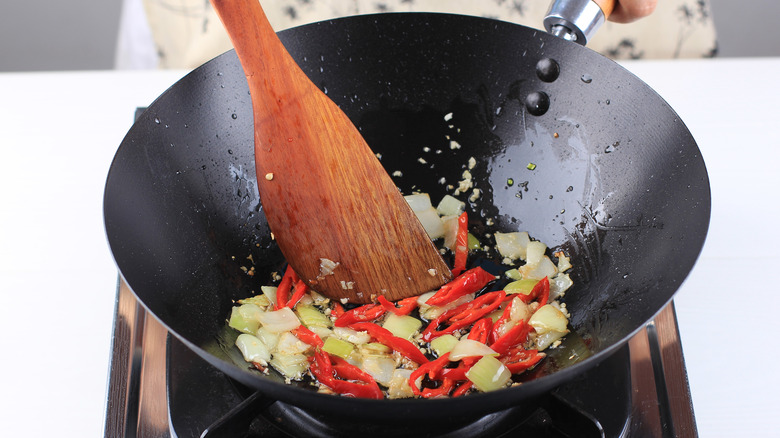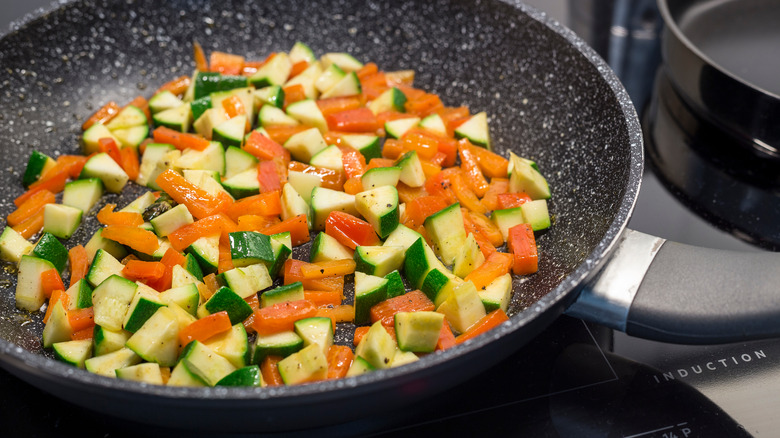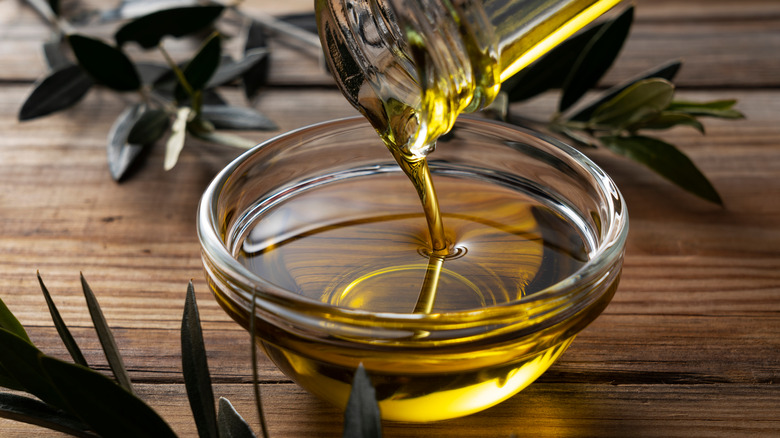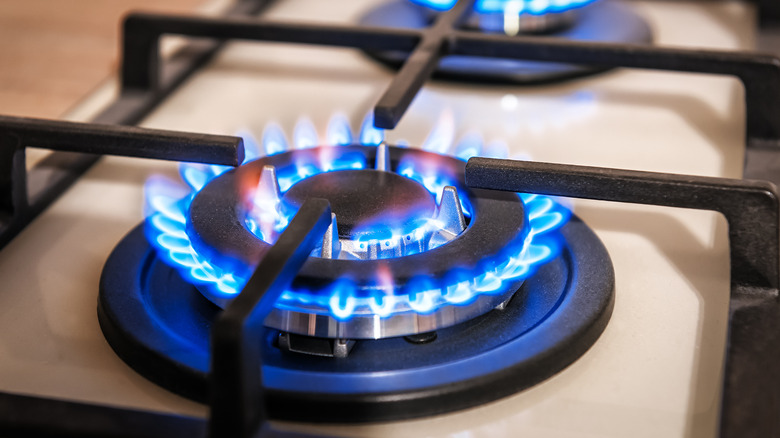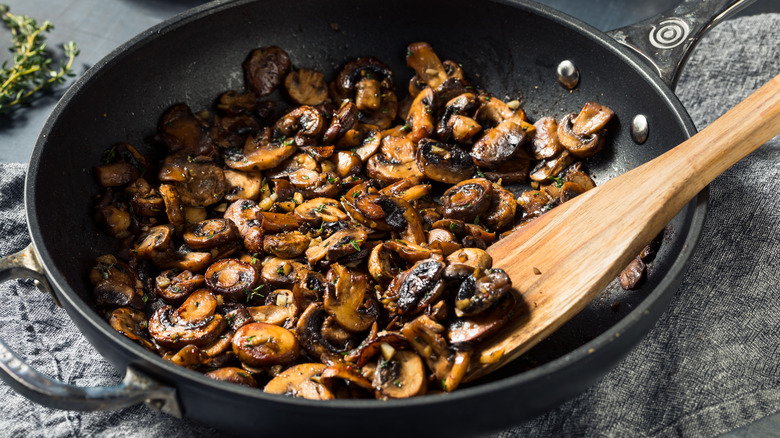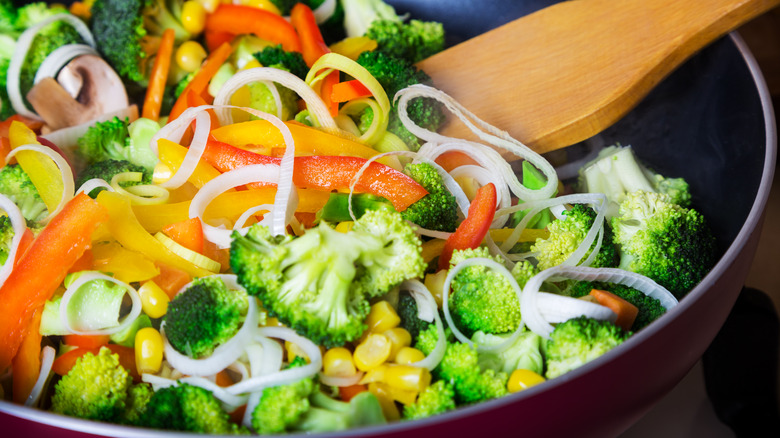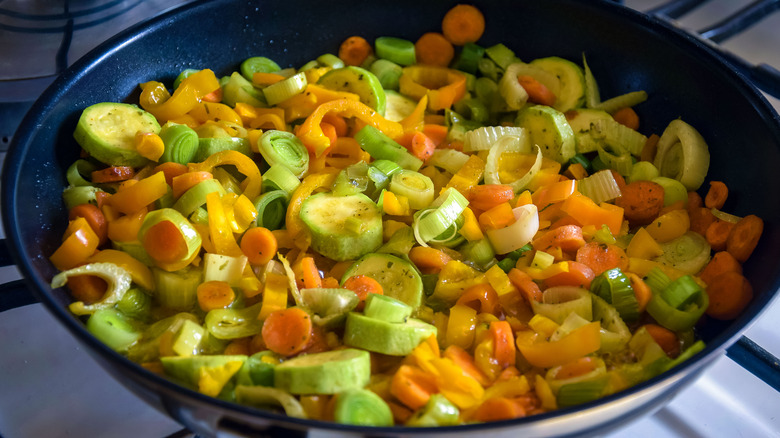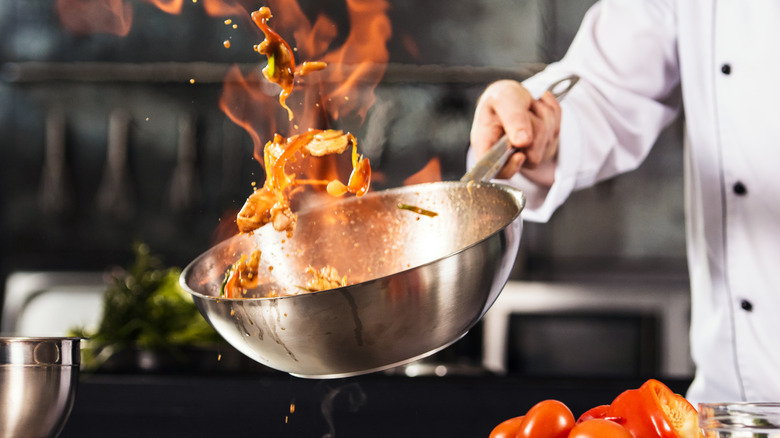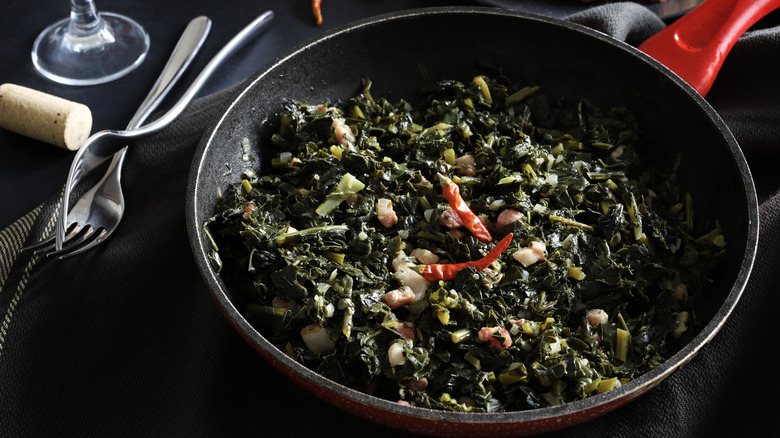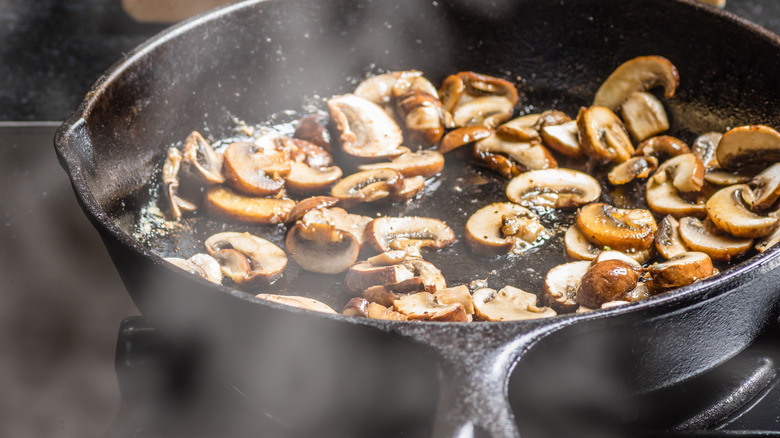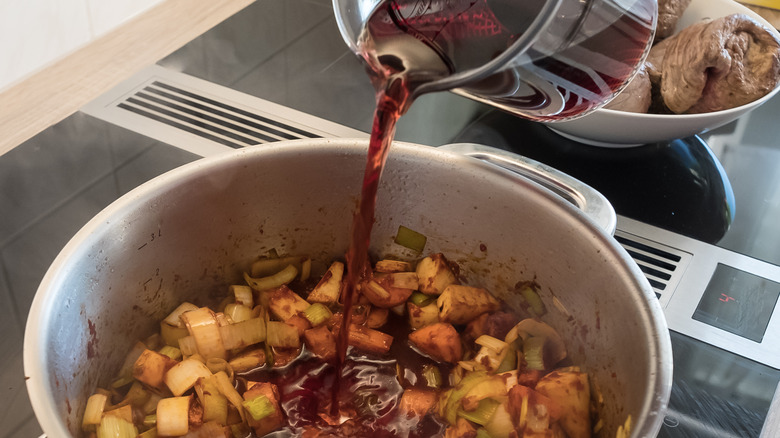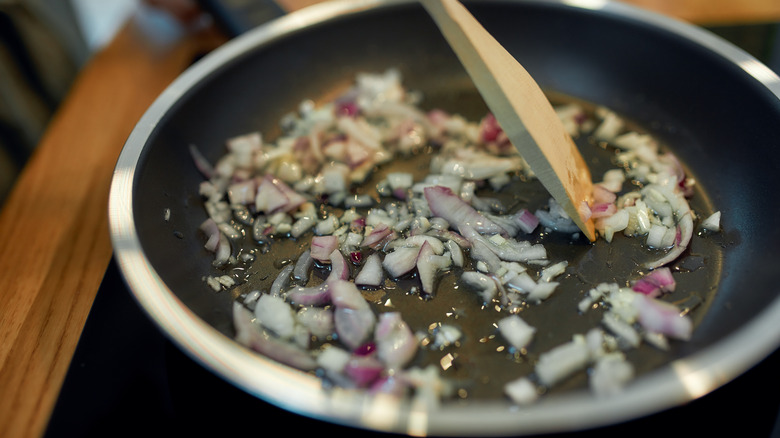Big Mistakes Everyone Makes When Sauteing
There are certain basic and essential cooking techniques every home chef should master. Baking. Steaming. Frying. Grilling. You can add sautéing to that list as well. Whether you're whipping up a DIY stir-fry, a pasta dish like shrimp scampi, or just a hearty and healthy side of fresh in-season vegetables, sautéing is a powerful and versatile method of food prep you can use on an almost daily basis.
According to Stephen Chavez, a Los Angeles-based chef and instructor at the acclaimed Institute of Culinary Education, sauté literally means "jump" in France where the technique originated — and that's exactly what the food you sauté should be doing: jumping around the pan as you cook it quickly over high heat. "Sautéing is essentially cooking a small, tender piece with a small amount of hot fat," he explained to Mashed. Some people call the process stir-frying, some call it pan frying, and some call it sautéing, he adds, but they're all basically the same technique.
But while sautéing is one of the most fundamental cooking techniques, it's also one that many home cooks frequently mess up — whether as a result of practicing poor technique, using the wrong ingredients or having technical issues like overcooking, undercooking, or cooking at the wrong temperature. Sound familiar? If so, don't worry! We've pulled together a handful of the country's top cooking instructors for solutions to all those commonly made sauté errors. With their advice, you'll soon be sautéing like a pro.
Don't reach for the wrong pan
When it comes to sautéing, any pan won't do. You need to use a proper sauté pan designed specifically for that use, says Jairo Ducos, director of operations and house chef at the De Gustibus Cooking School by Miele in New York City. "You want a pan with a heavy bottom and sloped sides," he told us. "That way the heat will distribute more evenly, and you'll be able to toss around all your proteins and ingredients more efficiently."
Heavy-bottomed pans allow for a more even transfer of heat, while the sloped sides allow greater access to the food so you can more easily keep everything moving. As for pan type, Ducos says, the material the pan is made with doesn't really matter — he likes stainless steel, aluminum, or cast iron.
"The key thing to look at is the pan size," he adds. You always want to err on the side of using the largest pan possible versus one that is too small, which causes your ingredients to end up piled on top of each other. You'll know you have a good pan if you add a bit of oil to the bottom and see bubbles all over as the pan heats up. If you just see isolated bubbles in a couple of spots, that means the pan has hot-spots. "It's worth the money investing in a good sauté pan," Ducos says. "But you only need one — you don't need a lot!"
Avoid sautéing with the wrong oil
Whether you're sautéing fresh diced veggies or chunks of your favorite protein, sautéing always requires a bit of oil. But to sauté properly, you also have to pick the right oil — one that will stand up to the sautéing process. Sadly, that's where many home cooks go wrong, LA chef Stephen Chavez says. "When you're sautéing, make sure you're using an oil that can handle relatively high heat or that has a high smoke point," he says. His go-to options include soy, canola, safflower, or sunflower oil.
"You can also use avocado oil or coconut oil, which is a little bit more trendy," he adds. "You can sauté in extra virgin olive oil, but I don't recommend it — it tends to burn and turn bitter at a higher heat. I don't recommend regular olive oil either. It's just not great for sautéing."
And despite its great salty flavor, butter is also a no-go for sautéing because all those delicious milk fats are prone to burning at high heat. The one exception if you have to have that butter taste? Search your market for an Indian product called ghee, which is a clarified butter with those milk fats removed. "We use that a lot in culinary school," Chavez says with a laugh, "because butter is gonna give you a great flavor. But I still usually pair it with a little bit of oil as well."
Never sauté at the wrong temperatures
Using the right temperature is essential if you want to properly sauté your food and form that perfect bit of crust while also locking in all that delicious flavor and moisture. For Lisa Counts, executive chef at The Chopping Block culinary school in Chicago, that means sautéing over high heat but only for a short period of time. "You should always preheat your pan before sautéing," Counts says. "I believe in adding the oil to the pan and preheating them together. When the oil starts shimmering or is just about to smoke, that's the indicator of when the pan is hot enough to start sautéing."
As for temperature, Counts says, "It's always best to sauté on a medium-high heat. It's always easier to turn down the heat, but it's harder to bring it back up again," she explains. "Plus, if you start too low, then you run the risk of ingredients absorbing much of the fat and ending up tasting greasy."
On the other hand, if you start too high, you risk burning your meal before it has had a chance to cook through. Ducos agrees on sticking with medium to medium-high heat. "You want the cooking process to start immediately when you drop your protein or vegetable into the pan," he says. "If it doesn't, then you end up slow-cooking or poaching your food instead of sautéing it, and you risk everything drying out."
Steer clear of overcrowding your pan
Many of us think sautéing or stir-frying a meal means piling a ton of ingredients in a pan or wok and then cooking everything at once. But when you do this, you aren't actually sautéing your food — you're steaming it. Heat causes moisture to evaporate from your various ingredients, and all that steam — rather than your oil — ends up cooking your food. This leads to limp, soggy protein and veggies instead of crispy, sautéed ingredients.
"There should be very minimal overlap of food in the pan when you sauté," chef Lisa Counts cautions. "Ideally, if you can still see the bottom of the pan just a tiny bit through all of the food, that is a good amount to be sautéing."
Chef Stephen Chavez agrees. "The more food that you put together in one pan, the more you're going to lose the ability to brown or crisp to get color on your ingredients," he says. "The more crowded your pan is, the more your ingredients are going to be touching each other — and the more likely they are to steam instead of getting a good crispy seal or crust."
Don't try to sauté all your ingredients at once
Cooking most food properly — whether it's a calzone, a cake, or a casserole — requires some sort of order. You have to have a system in place for combining ingredients. And sautéing is no different. If you want a sautéed dish to taste great, you have to plan how it comes together. "Dumping everything in the sauté pan all at once is the mistake I see most often," chef Lisa Counts says. "Starting with more fibrous veggies then adding in vegetables that have a higher water content is the order I tend to follow when adding things to the pan."
Christopher Diamond, a chef and instructor with the Cambridge School of Culinary Arts in Massachusetts agrees with this staggered sautéing approach. "You should generally put your densest ingredients in the sauté pan first — onions and carrots, for example. Then add softer ingredients like peppers and zucchini. And if you're sautéing a protein, it's generally best to cook that first and then add it back in with your other ingredients," he says.
Cooking a big meal? Sauté in batches rather than trying to cook everything all at once. "You can't go wrong with sautéing all of one veggie, taking it out of the pan, then sautéing another veggie, and so on," Counts says. "Then, when everything is cooked, mix it together in the pan for a quick reheat. This is how I approach stir-fries, for example."
Make sure your sauté isn't bland!
Nobody likes flavorless food. And if you're going to the effort of making a nice sautéed meal, you definitely don't want your poor spice game to be the difference between everyone clamoring for seconds or them turning up their noses and asking for takeout instead. Luckily, amping up the flavor in any sautéed dish isn't hard.
According to chef Stephen Chavez, creating a great-tasting sauté all comes down to seasoning — adding salt and pepper in proper levels and at the right times and including fresh herbs or dried spices in your dish to increase the natural flavors. "When you season, you want to season all the way through the cooking process," he says. "So even before I put my ingredients into the pan, I may toss each of them individually with a bit of salt and pepper. And then I taste as the food cooks and add more salt and pepper as needed."
As for flavoring with herbs and spices, that should generally happen at the end, says Salvatore Rizzo, owner and CEO of the De Gustibus Cooking School by Miele in New York City. "You don't want your herbs or spices to end up burnt," he says. "Unless it's a rub or crust on your beef or chicken or pork, I always prefer adding any fresh herbs or dried spices near the end of the cooking process so they don't overcook or become bitter."
Don't forget to practice your sauté technique
Sautéing food basically means ensuring all your ingredients are "jumping" in the sauté pan. Doing that, chef Christopher Diamond says, can be as simple as keeping everything moving as you cook. "You want almost constant movement in your pan," he says. "Grab your big metal or wooden spoon or a large spatula, and just keep moving everything around so it's being exposed to the hot oil on all sides and can cook through."
To make your sautéing more impressive, you can also use the tossing technique commonly seen on TV. "This is the technique you see where people are using one hand to flip all these different ingredients in a pan," chef Stephen Chavez says.
Fortunately, it's easier than it looks. "The most important thing to remember is that it's just a little push," he says. "As long as your pan has sloped edges, you just give it a little gentle push forward, and the food will go up in the air like someone going off a skateboard ramp. Then, all you have to do is catch it." To practice, Chavez suggests putting a piece of bread in a pan and then tossing it and catching it. From there, you can move on to dried beans — and then actual food you are cooking. "Do it while watching TV," he says with a laugh. "Push, flip, push, flip over and over until you get the feel for it."
Never let your sauté get too wet
Moisture and humidity are the enemies of sautéing. One of the most important mistakes to avoid when sautéing anything is to not let your ingredients get too wet. Whether you're overcrowding your sauté pan, you aren't drying your ingredients off after washing them, or you're just cooking something that contains a lot of natural moisture like mushrooms, you don't want any extra liquid in your sauté, chef Salvatore Rizzo says. "That water is just going to evaporate due to the heat and create steam," he says.
And if you're steaming your food, you aren't sautéing it. "Sautéing is a dry cooking method. It is not a moist cooking method," chef Stephen Chavez says. "Don't overcrowd your pan. Don't put the lid on your pan and trap all that excess steam that's cooking off your ingredients. Don't put something that's been in a marinade into your pan without removing that excess moisture. If you do, you're not going to get that crispy brown crust you want from your sauté."
He adds: "Imagine you're sautéing some fried rice. You use day-old rice because it's dried out and not all wet or mushy. If you try to make fried rice by cooking some rice and then throwing that fresh rice into a pan, it doesn't work. The same holds true with anything you are trying to sauté — it can't be too wet, or the sauté won't turn out."
Avoid overcooking when sautéing
Since sautéing involves relatively high temperatures, hot oil, and a short cooking period, it can be incredibly easy to overcook your food. Even if you don't technically burn it, meat can come out chewy, vegetables might get mushy, or the whole dish can just seem dry and tough.
For chef Lisa Counts, visually watching the progression of the food as it cooks and keeping tabs on its texture are her most important clues to figuring out when a sautéed dish is done. "When all of the food is evenly browned or softened to your liking, you know you are done," she says. "I generally tell people they need to trust their gut. All veggies should have a bit of a crunch to them. I am always tasting my food as I cook. The same goes for sautéing! ABT as we say in culinary school — always be tasting."
Chef Christopher Diamond follows a similar approach to keeping tabs on the food he is sautéing, primarily focusing on taste. "How do you tell when your dish is done?" he asks. "You eat a piece of it. You've gotta be tasting and eating constantly. Don't burn yourself. But only you know how you like your vegetables, so you have to keep trying them to make sure they are ready. You can't just rely on other factors like how long something has been cooking or what temperature it's been cooking at."
Don't forget to deglaze your pan
Deglazing a pan — using a liquid like wine or stock to loosen and dissolve the browned bits of food left after cooking — is most commonly used after roasting or searing. But if you're not deglazing after you sauté a meal, you're missing out on a wealth of flavor and delicious savory sauces. "If you want to increase the flavor in any sautéed dish, deglazing is a great way to do it," chef Jairo Ducos says. "You're scraping up all that goodness on the bottom of your sauté pan. It's fantastic."
The process of deglazing is easy. You just remove all of your cooked meat or vegetables from the pan, set them aside, and then add your liquid of choice until the bottom of the pan is just covered or submerged by about a quarter of an inch. Add a bit of butter and simultaneously work to stir and scrape up all those browned bits from the bottom of the pan using a wooden spoon or a whisk. This is called making a pan sauce.
"I describe deglazing as adding a liquid to the pan in order to cool it down, clean the drippings from the bottom of the pan, and create a sauce which can add depth of flavor to your dish," chef Lisa Counts says. "Generally, you deglaze with wine, spirits, citrus, or vinegar, but water can work as well. Whichever you use, the sauce will absorb some of that flavor."
And perhaps the biggest sauté mistake of all: Don't burn your garlic!
If you've ever been deep in the midst of making what you hoped would be an incredible dish, only to turn your back for a second ... and return to a pan full of bitter, burned garlic, take heart! You're not alone in this incredibly common sauté blunder. "I would have to say, especially with our classes, that burned garlic is a big problem for a lot of home cooks," chef Jairo Ducos says. "People just don't know the timing of putting the garlic in their pan."
Because garlic is packed with natural sugars, amino acids, and all those sulfur-containing compounds that create its pungent flavor and aroma, it burns incredibly easily whenever it comes into contact with a hot surface. "When adding garlic to a sauté, the rule I always follow is adding it when the vegetables are about 95% cooked," chef Lisa Counts says. "Garlic only takes about 30 seconds to a minute to cook through — so it doesn't need to be in a pan for very long."
"This is another reason why having all your ingredients pre-chopped and ready to go is so important," chef Christopher Diamond says. "You always want to have your next thing ready to go when you are cooking and especially when you are sautéing. Step away for a second to get something, and your whole dish — including the garlic — could be ruined." And nobody wants that!
